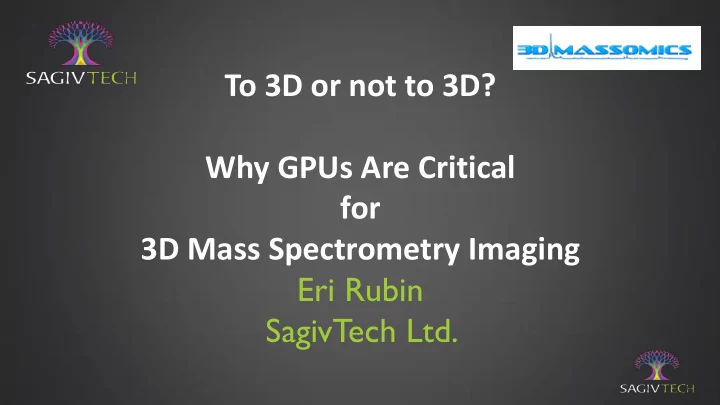

To 3D or not to 3D? Why GPUs Are Critical for 3D Mass Spectrometry Imaging Eri Rubin SagivTech Ltd.
SagivTech Snapshot • Established in 2009 and headquartered in Israel • Core domain expertise: GPU Computing and Computer Vision • What we do: - Technology - Solutions - Projects - EU Research - Training • GPU expertise: - Hard core optimizations - Efficient streaming for single or multiple GPU systems - Mobile GPUs GTC 2015, San Jose
What is Mass Spectrometry ? • A sample is ionized, for example by bombarding it with electrons. • Then, some of the sample's molecules break into charged fragments. • These ions are then separated according to their mass-to-charge ratio. GTC 2015, San Jose
What is Mass Spectrometry ? Two ways of looking at MALDI data: 1) Set of spectra measured at different positions 2) Set of images representing molecular distribution for different m/z values GTC 2015, San Jose
MALDI imaging as a BIG DATA problem • Big Data – A 2D MALDI-IMS dataset exceeds 1 gigabyte, typically comprising 5.000-50.000 spectra of approximately 10.000 bins length. – A 3D MALDI-IMS dataset is built of 10-50 2D datasets of serial sections, reaching up to 100 gigabytes per dataset. • Complex Algorithms GTC 2015, San Jose
Probabilistic Latent Semantic Analysis • PLSA - A PCA alternative for detecting strong components • A measure of image spatial chaos • Used for detecting strong components in hyper spectral data (PCA alternative) • Uses simple algebraic operations • Algebra is a perfect fit for the GPU! GTC 2015, San Jose
PLSA- Results Num Num Num CPU GPU Factor Channels Spectra Components time[sec] time[sec] 900 125 15 3.05 0.842 3.62 900 125 64 8.5 0.872 9.75 1800 250 64 36.5 1.607 22.71 3600 500 64 128.91 3.532 36.50 7200 1000 64 525.13 11.32 46.39 1800 250 128 56.4 1.85 30.49 3600 500 256 402.67 6.74 59.74 GTC 2015, San Jose
A measure of image spatial chaos • Images can contain real objects or just noise • Measure the “spatial chaos” • Images with objects have less chaos. • For hyper spectral data: – Each image comes from a spectra – Images with less chaos correspond to an interesting spectra. Peak picking! – Can be used to identify molecules GTC 2015, San Jose
MOC Results • Depends on search radius! • Per image: – CPU i5 2.5GHz - 310ms per image – GPU k20 – 1.6ms per image ~x190 GTC 2015, San Jose
PCA acceleration via SVD acceleration • The SVD (Singular value decomposition) and Scores calculation sections of the PCA were implemented. • The SVD is defined by: A = U*S*Vt • The SVD is the most time consuming section of the PCA. • The SVD implementation uses the CULA library. GTC 2015, San Jose
SVD GPU Results (Kepler K20) • The SVD computation on the GPU Width Height Time in Seconds 256 256 0.0092 512 512 0.3 1024 1024 1.2 4.7 2048 2048 4096 4096 18.9 4 159 6972 26.7 GTC 2015, San Jose
Hierarchical Clustering Distance GTC 2015, San Jose
Hierarchical Clustering Distance • The distance calculation is defined as matrix multiplication with its transposed matrix. • CUBLAS is used to perform an optimized matrix multiplication. • CUBLAS functionality is used also to transpose the matrix of signals in the device memory. • GPU kernels were written to perform the final normalization and conversion to single precision. • The Thrust library is used for sorting. • The computation is done in blocks. GTC 2015, San Jose
Results Num data per Number of GPU Memory Time signalsx signal minimal GB (seconds) distances 40000 1000 10000 2.0 4.5 40000 2000 10000 2.37 6.2 40000 3000 10000 2.77 7.9 about x20 from CPU results GTC 2015, San Jose
SagivTech Infra Stack Our Infra is composed of a set of modules STMultiGPU STGL STCuda STCudaK Interop Functions ernels STStreamingGPU STInfraGPU STInfraSys GTC 2015, San Jose
Main Attributes of SagivTech’s Streaming Infrastructure • Pipelining : hides memory transfer overhead between CPU and GPU • Asynchronous work : allows job launch on multiple GPUs without waiting for one GPU to finish • Peer-to-peer communication : enables transfer of data between multiple GPUs within the same system GTC 2015, San Jose
GPU streaming GTC 2015, San Jose
SagivTech Presents: A middleware for Real Time Multi GPU Renderer GTC 2015, San Jose
ST MultiGPU Real World Use Case One GPU FPS: 4.25 One pipe Scaling: 1.00 Utilization: ~70% Note the gaps in the profiler GTC 2015, San Jose
ST MultiGPU Real World Use Case FPS: 5.41 One GPU 4 pipes Scaling: 1.27 Utilization: 98% Better utilization using pipes GTC 2015, San Jose
ST MultiGPU Real World Use Case FPS: 20.46 Four GPUs Four pipes Scaling: 3.79 – Near linear Scaling! Utilization: 96%+ Note NO gaps in the profiler GTC 2015, San Jose
3D Massomics • This project is funded by the European Union, FP7 HEALTH programme Grant agreement no. 305259. GTC 2015, San Jose
Thank You F o r m o r e i n f o r m a t i o n p l e a s e c o n t a c t N i z a n S a g i v n i z a n @ s a g i v t e c h . c o m + 9 7 2 5 2 8 1 1 3 4 5 6
Recommend
More recommend